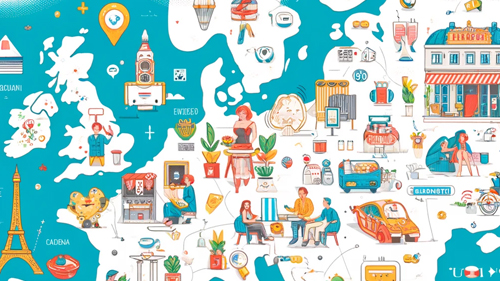How to Tailor Your Website for the European Market: A Comprehensive Overview
Sunday, June 2nd, 2024

Ever wondered how your online content would perform in a European context? Buying European web visitors isn’t just about numbers; it’s about understanding and engaging with a culturally diverse audience. This article explores how adapting your content and marketing strategies to suit regional tastes can lead to better engagement and sustained visitor interest across Europe. By tapping into this diverse market, you can enhance your digital footprint significantly. Imagine connecting in a meaningful way with a café owner in Rome or a fashion blogger in Paris—all through your website. Each interaction is an opportunity to broaden your influence and deepen your understanding of diverse consumer landscapes, setting the stage for lasting business relationships.
Understanding Cultural Variance:
Embrace the Diversity
Each European country has unique cultural preferences and internet usage patterns. To effectively engage European web visitors, it’s crucial to recognize these differences. For instance, what works in Spain might not resonate in Sweden. Tailoring your content to reflect local languages, cultural nuances, and even humor can significantly boost engagement. By integrating local trends and preferences into your content, your brand can feel more relatable and trusted. Imagine adapting your marketing campaigns to celebrate Fête de la Musique in France or incorporating references to local football clubs in UK blog posts. Such specific adjustments not only show respect for local cultures but also demonstrate your brand’s commitment to its new audience, potentially leading to higher retention rates and stronger customer loyalty.
Optimizing for Local Search Engines:
Visibility Across Borders
While Google dominates globally, don’t overlook local search engines like Yandex in Russia or Seznam in the Czech Republic. Optimizing for these can help you capture a broader audience. This means localizing keywords, understanding local SEO practices, and creating content that aligns with what local audiences are searching for. Enhancing visibility in this way not only increases website traffic but also boosts your site’s relevance and authority in these markets. Consider collaborating with local SEO experts who can provide insights into regional search behaviors. Such partnerships can unearth opportunities to outshine competitors and secure a prominent online presence in untapped markets.
Adapting Payment Options:
Ease of Transaction
Europeans have diverse preferences for online payment methods. While credit cards are widely used, many countries have preferred local methods; for example, iDEAL in the Netherlands, and Sofort in Germany. Offering these options can remove barriers to conversion, making it easier for European visitors to make purchases or subscribe to services directly from your site. Adding these payment options not only simplifies the checkout process but also reassures users about the security and authenticity of your platform. By aligning with local financial practices, you’re effectively saying, “We understand and respect your norms,” which can significantly enhance trust and user satisfaction.
Local Regulations and Compliance:
Navigate with Confidence
Europe takes data protection and consumer rights seriously, as evidenced by GDPR. Ensuring your website complies with these regulations not only builds trust but also prevents costly penalties. This includes having transparent data practices, secure handling of customer information, and clear communication about consumer rights on your website. Compliance is not just about avoiding fines; it’s about establishing a foundation of trust. When customers see that a site respects their privacy and rights, they are more likely to engage deeply and become repeat visitors. This approach turns regulatory compliance into a competitive advantage, distinguishing your business in a crowded marketplace.
Engaging Through Social Media:
Leverage Local Platforms

While global platforms like Facebook and Instagram are popular in Europe, local platforms like VK in Russia or Xing in Germany also hold significant sway. Engaging with European audiences on these platforms can help amplify your reach and build community around your brand. Tailor your social media strategies to include local languages and region-specific content. This not only increases engagement but also fosters a sense of community and belonging among users. Using social media to interact directly with European customers can provide invaluable feedback and generate buzz, turning passive viewers into active participants and brand advocates.
Content Localization:
More Than Translation
Effective localization involves more than translating your website into different languages. It includes adapting the images, colors, and design elements to align with local tastes. For example, vibrant colors might appeal in Southern Europe, while Nordic countries prefer minimalist designs. Such nuances can make your website more appealing and user-friendly for different European audiences. It’s akin to customizing a greeting card for a friend; personal touches can turn a generic note into something heartfelt. Similarly, local adaptations in web design signal respect and thoughtfulness, potentially increasing user engagement and satisfaction.
Ready for growth? Explore top strategies for acquiring unlimited free website traffic in 2025.
Performance and Hosting:
Speed Matters

Website speed and reliability are crucial for keeping visitors engaged. Hosting your site or parts of it on local servers can dramatically reduce loading times for European visitors. Consider cloud services that offer regional hosting options to ensure your site performs optimally across Europe. Faster loading times not only improve user experience but also boost SEO rankings, as search engines prioritize quick-loading sites. This technical adjustment can be a pivotal factor in whether a new visitor becomes a loyal customer or bounces in frustration. Efficient hosting services are like the backbone of your site’s operations in Europe—strong and reliable, they keep everything running smoothly, ensuring that your content reaches users swiftly and securely.
Conclusion:
Tailoring your website to cater to the European market involves understanding and integrating various cultural, economic, and technical factors. By adapting your strategies to the unique needs and preferences of different European audiences, you can ensure your investment in buying European web visitors pays off. Remember, the goal is to not just attract traffic but to engage and convert these visitors into loyal customers. With thoughtful adjustments and a focus on local relevance, your site can thrive in the diverse and dynamic European market. This thoughtful adaptation not only enhances your website’s appeal but also deepens your connection with a broad and diverse audience, paving the way for long-term success.
Filed under: Tips & Tricks
Exclusive Offer!
1,500,000 Points for $110 $68. If you're running low on points — don't miss out
limited time